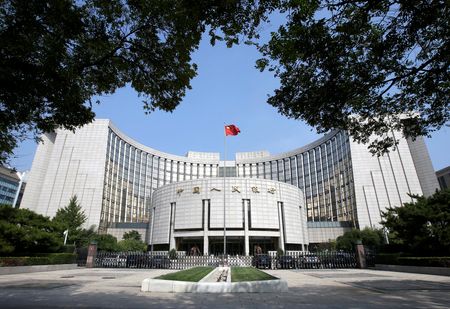SHANGHAI (Reuters) -China surprised markets by cutting major short and long-term interest rates on Monday, its first such broad move since August last year, signalling intent to boost growth in the world’s second-largest economy just days after a Communist Party leadership meeting.
The cuts to the central bank’s key short-term policy rate, its market operations rates and benchmark bank lending rates came after China reported weaker-than-expected second-quarter economic data last week and its top leaders met for a plenum that occurs roughly every five years.
The country is verging on deflation and faces a prolonged property crisis, surging debt and weak consumer and business sentiment. Trade tensions are also flaring, as global leaders grow increasingly wary of China’s export dominance.
“The cut today is an unexpected move, likely due to the sharp slowdown in growth momentum in the second quarter as well as the call for ‘achieving this year’s growth target’ by the third plenum,” said Larry Hu, chief China economist at Macquarie.
The People’s Bank of China (PBOC) said on Monday it would cut the seven-day reverse repo rate to 1.7% from 1.8%, and would also improve the mechanism of open market operations. That is the first cut to the rate since August 2023.
Minutes later, China cut benchmark lending rates by the same margin at the monthly fixing. The one-year loan prime rate (LPR) was lowered to 3.35% from 3.45% previously, while the five-year LPR was reduced to 3.85% from 3.95%.
The PBOC subsequently lowered the rates on its standing lending facility (SLF), a type of loan that it gives commercial banks to fulfill their temporary cash demands, by the same amount.
Ju Wang, head of Greater China FX & rates strategy at BNP Paribas, said that growing expectations for the Federal Reserve to start cutting interest rates also gave the PBOC room to ease its policy, given the pressure the yuan has been under because of a wide yield gap with the dollar.
The official Xinhua news agency cited unnamed sources close to the PBOC as saying the “decisive” rate cut showed its determination to bolster the recovery and it was in response to the plenum’s aims to achieve this year’s growth target.
The PBOC also made adjustments to its lending programme, saying collateral requirements for medium-term lending facility loans will be lowered from July.
Analysts said that meant banks would need to hold fewer longer-term bonds for collateral needs and could sell or trade more, helping the central bank with its mission to put a floor under longer-term yields, rein in a bubble in bonds and get a steeper yield curve.
Following the rate cuts, China’s yuan dropped to a near two-week low of 7.2750 per dollar, before paring some losses.
Chinese sovereign bond yields fell across the curve, with 10-year and 30-year down as much as 3 basis points, before stabilising at 2.24% and 2.45%, respectively.
China’s 30-year treasury futures for September 2024 delivery were up 0.33% in afternoon trade on Monday.
“The fact that PBOC didn’t wait for the Fed to cut first indicates that the government recognises the downward pressure on China’s economy,” said Zhang Zhiwei, president and chief economist at Pinpoint Asset Management.
He expects more rate reductions in China after the Fed begins a rate-cutting cycle.
China’s rate cuts are aimed at “strengthening counter-cyclical adjustments to better support the real economy,” the PBOC said in a statement.
The announcement also comes after the PBOC said it would revamp its monetary policy transmission channel. PBOC Governor Pan Gongsheng said last month the seven-day reverse repo basically serves the function of the main policy rate.
“This is also a reflection of the improvement of the market-oriented interest rate mechanism,” Xinhua quoted the source as saying.
(Reporting by Shanghai and Beijing newsrooms; Editing by Vidya Ranganathan, Jamie Freed and Jacqueline Wong)











